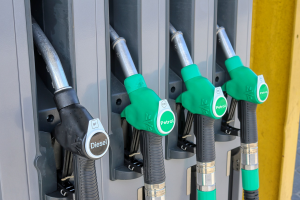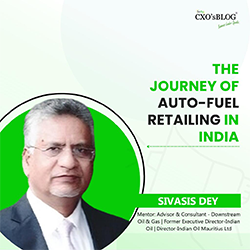Written by: Sivasis Dey
About the author: Mentor: Advisor & Consultant – Downstream Oil & Gas | Former Executive Director-Indian Oil | Director-Indian Oil Mauritius Ltd

As a professional from the Energy Sector, I feel one of the sectors, which have undergone tremendous transformation in India, during the last couple of decades, is Auto-fuel retailing. From a regime of Administrative Price mechanism (APM) and from a mode of traditional distribution, it has slowly but steadily moved into an era of competition and marketing.
Petroleum retailing was the domain of PSU Oil Cos since the time of nationalisation of private Oil Cos during 1974/1975. However, the story changed over time, since late nineties, with the threat of Private Oil Cos entering the market, forcing the PSU Oil Cos to gear up for the competition. Some of the PSUs roped in the big names in the Business Consulting domain to develop their business strategy.
The market dynamics actually changed with the Government of India’s liberal and well thought policy of March 2000, allowing Cos (making prior investment of INR 2000 crore in the Oil & Gas sector) to enter the fuel retailing business, which paved the way for Reliance Petroleum, Essar & Shell in 2004-05. It set the cat among the pigeons.
The Oil Marketing Companies (OMCs) came up with different strategies. From modernizing the outlets and upgrading the service levels to loyalty programs etc. to thwart the competition, but not before an estimated 5% market share drifted to the kitty of Pvt Oil Cos in a short span of time.
This was also the time of advent of branding in auto-fuel retailing in India. While BPCL launched ‘Pure for Sure’, IOCL launched ‘Xtracare’ and HPCL introduced ‘Club HP’, with different brand promises and service standards in terms of Quality & Quantity, convenience, customer experience etc. in the urban market segment.
The Highway market, which is the biggest pie in HSD business, also came under focus. The Oil Cos jostled for brand positioning in the form of large format Outlets with wayside amenities and other allied services. While IndianOil launched large format Retail Stations under the brand ‘Swagat”, BPCL introduced ‘Ghar’ Outlets to match “A1 Plaza” of Reliance etc.
The noise in the Urban & Highway segment had its ripple in the rural market as well with growing aspiration of rural consumers for better retail experience of auto-fuel. ‘Kishan Seva Kendra’ (KSK), the one-stop Rural Outlet for daily provisions including fuel for the agri sector was launched By IOCL in a path breaking initiative in 2005.
There was more in the game. Oil Cos resorted to strategies in terms of product and price as differentiators to fight the fierce competition. OMCs launched branded petrol with varied attributes and benefits, Xtrapremium (IOCL), Speed (BPCL), poWer (HPCL) etc. However, with the passage of time these became hygiene factors and OMCs resorted to service excellence as differentiator. The best of Training / Management Institutes were roped in to train the Channel partners and the Customers Attendants, being the first point of contact with the Consumers.
While these were not enough, OMCs reinforced and rejuvenated Non-fuel services as a differentiator. The motorists now had the privilege of picking up their daily provisions along with the fuel from the ‘Convenio’ or ‘In & Out’ or ‘Happy Shop’ stores. Some up-market pockets experienced ‘valet fuelling’ facility offered by the established and reputed Channel partners.
Neat and clean Petrol stations, assurance of Quality & Quantity, branded fuel, nonfuel services, loyalty cards etc. soon became common. Oil Industry embraced technology as a value proposition. Manual dispensing machines had long back given way to electronic pumps already in the early nineties and these were now replaced by sophisticated automation compatible Dispensers with more precision, security measures and accuracy. Oil Cos ushered in the path-breaking initiative of automating the Retail Outlets preparing for the digital journey lying ahead. While fully automated Stations helped Oil Cos to manage the network effectively on a remote basis and aided in business decisions, consumers were benefitted in terms of assurance of value.
The GOI policy of 2019, yet another liberal policy, permitting Entities with net-worth of INR 250 crore to enter the auto-fuel retailing, pushed things further. The approval comes with customer facing requirements, with 5% of the fuel stations to be setup in remote areas and fully automated stations offering at least one environment friendly fuel like CNG, AutoLPG, EV charging etc. other than Petrol/ Diesel. Quite a few Entities have been accorded permission already and it all augurs well for the ever-growing auto consumers in India. More the competition, more shall be the choice and better shall be the customer experience.
The pandemic has made home delivery a part of our buying habits. Oil Industry introduced Diesel Door Delivery (DDD) to certain specific sectors in line with the norms of The Petroleum Explosives Safety Organization (PESO) and Users of static / heavy equipment became major beneficiaries. The initiative also opened avenues for Startups who as a part of the value chain, contributed towards fuel delivery with convenience and ease at the doorstep of the consumers.
The world of auto-fuel retailing in India is changing towards energy retailing, especially in view of environmental concern. Availability of compressed natural gas (CNG), which is a comparatively cleaner and cheaper fuel, is becoming increasingly popular, courtesy the Government’s CGD policy. Industry, is preparing to introduce Liquefied Natural Gas (LNG) for long haul transport segment in the highway market. There is increased focus on Biofuels too. Compressed Bio Gas (CBG) has been launched as Sustainable Alternative towards Affordable Transportation (SATAT) fuel in several markets. The country is gearing up for an ambitious milestone of supplying 20% ethanol blending petrol by 2025, which will help in reducing carbon emission and also reduce expenditure on crude oil imports.
While all these are happening, EVs are making a slow and steady entry in Indian market but may require some time for a significant transformation in view of socio-economic and technical factors.
As a journey ahead, Fossil fuels will continue to remain a dominant component in the entire basket of auto-fuel for some time to come along with biofuels and the emerging renewables. Technology will continue to further disrupt the service levels and the Customer experience at the Retail Outlets. With our country experiencing large digital transformations, the Indian consumer is waiting to experience more innovation at the Forecourt. The excitement to experiment self-fueling, pleasant experience of robotic arm automatic fueling, increased safety at Petrol stations based on Internet of things (IOT) and the delight of seamless digital experience as one drives into a digitally managed fuel station are some of the aspirations of Indian consumers. It will surely dawn one day, but how soon, is the point.
